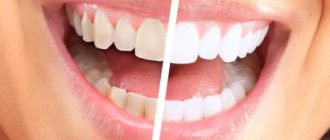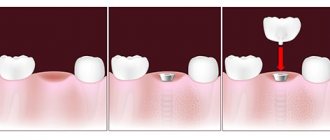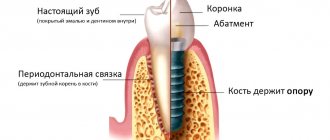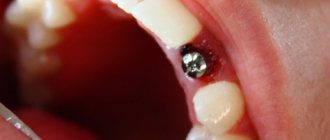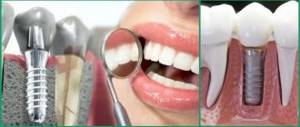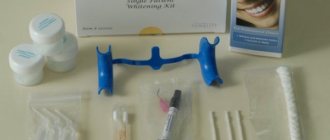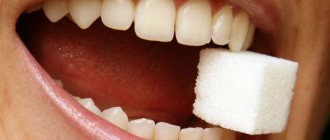Bone atrophy is a huge problem during future implantation. In most cases, it can be solved by installing an implant at an angle or performing a sinus lift. But in a number of cases associated with the consequences of injuries and surgical interventions, there is no bone left at all. This is especially critical for the upper jaw.
Using conventional methods, it is not possible to carry out implantation in cases of complete or partial edentia against the background of total bone deficiency. Therefore, highly specialized implantation technology is most often used - Zygoma zygomatic implants are placed.
Design features of zygomatic implants
Zygoma implants are elongated titanium rods (up to 52.5 mm) with a cylindrical cross-section, screw thread and angled neck. The latter makes it possible to place the crown on a support located at an angle to the gum. Implants are installed not in the jaw bone, but in the denser zygomatic bone, the structure of which does not change even with prolonged absence of teeth.
In the case of a complete absence of teeth in the upper row, but a sufficient amount of alveolar bone tissue, the supporting system for the prosthesis will include two root and zygomatic implants. If there is a deficiency in the amount of bone, then Zygoma implantation will come in handy. It is based on the concept of "all on four" pillars.
Scheme of installation of Nobel Zygoma implants fixed in the zygomatic bone area
The essence of the technique is the placement of supports in the zygomatic bone of the upper jaw at a special angle, which provides a reliable foundation for the prosthesis, as well as distribution of the chewing load.
Advantages and features of the technology
| Advantage | How is it achieved |
| Shortened treatment times | The duration of treatment is from one to a maximum of 7 days (from the moment of surgery to installation of the prosthesis). A whole range of teeth can be restored in one visit |
| High aesthetics of the prosthesis | The prosthesis has a metal base, which is hidden under an acrylic base (artificial gum). Crowns are made of metal-plastic or ceramic composite. Such a prosthesis is at the same time lightweight, which allows it not to overload the installed implants, and is quite aesthetic and functional. |
| Complete external transformation | Due to instant prosthetics, the patient begins to smile again - wrinkles are smoothed out and mood improves. Implantation and complete restoration of teeth allows you to achieve a rejuvenation effect |
| No sinus lift required | Lateral implants are fixed at an angle and use the cheekbone for attachment. Therefore, jawbone augmentation is not required, even if there is extreme atrophy of the lateral regions |
| Minimum contraindications to treatment | Zygomatic implantation is possible in case of atrophy of the lateral parts of the bone tissue of the upper jaw, as well as in the presence of periodontitis, periodontal disease and osteomyelitis. This is explained by the fact that the implants are attached to the zygomatic bone, which is almost not subject to resorption and inflammation. |
| High degree of implant fixation | Using the zygomatic bone eliminates the risk of implants loosening or falling out, even under immediate loading. The structures have the highest primary stabilization in the bone - from 60 to 100 Newtons |
| Long service life and minimal risk of implant rejection | Achieved due to the absence of inflammatory processes in the zygomatic bone, since it is more sterile. According to clinical studies by Nobel1, the survival rate of zygomatic implants is 95.2% over a 10-year period, however, based on our own practice, we can say that the survival rate of zygomatic implants, if the technology is followed, is not lower than 98% |
| Wide possibilities of prosthetics | After complete fusion of the implants with the bone tissue (on average after six months to a year), the first adaptation prosthesis can be replaced with any aesthetic design - made of metal ceramics or zirconium |
Indications for zygoma implantation
Nobel Biocare Zygoma implants are indicated for installation in the following cases:
- absence of all teeth of the upper row;
- the patient has pathologies that make it impossible to perform classical implantation;
- severe atrophy of the bone jaw structures;
- there are contraindications to bone augmentation and bone grafting;
- there is a complex defect of the maxillary sinuses;
- complete edentia due to serious trauma or malignant process.
Usually, for the problems listed above, the only solution is removable prosthetics. This is not always convenient; artificial teeth can fall out at the wrong time. A jaw removed overnight and left in a glass is not a good prospect. Plus, food debris constantly gets clogged under such dentures. These moments of discomfort for the patient became decisive in the decision of the American company to develop a zygomatic implant system.
Contraindications
Zygomatic implantation is a complex traumatic process that has a number of contraindications:
- diseases of the nervous system;
- poor blood clotting;
- cardiovascular pathologies;
- serious disruptions in the functioning of the immune system (AIDS);
- hepatitis;
- uncompensated diabetes mellitus;
- malignant formations;
- infectious, inflammatory processes in the acute stage;
- tuberculosis.
Implantation is not advisable during pregnancy and breastfeeding.
Advantages of the system over the classical method
The surgical protocol for the classical technique of implanting the upper lateral units usually involves a preliminary sinus lift to build up the bone while simultaneously raising the floor of the maxillary sinus. This takes a lot of time and involves additional expenses.
Zygoma implants allow you to quickly restore the entire dentition without waiting for an increase in bone volume.
The difference between implantation with Zygoma systems and the traditional method is the immediate loading of structures with prostheses , the possibility of carrying them out in cases of oncological diseases. An undeniable advantage is the cost of implants. Fewer steps in the procedure significantly saves costs.
What should a patient consider when choosing a clinic?
Implantation using Zygoma zygomatic implants requires high-quality manual skills and skill of the implantologist. The operation itself takes place without visual control. Therefore, it is very important to find a surgeon who has extensive experience in zygomatic implantation.
Zygomatic implantation is a difficult operation for the doctor, but not for the patient. Within a week, the patient pleases those around him with his new smile, enjoys life himself, having forgotten the discomfort and difficulties of edentulism in the upper jaw.
If you find an error, please select a piece of text and press Ctrl+Enter.
Tags
Did you like the article? stay tuned
No comments yet
Preparation and protocol for installation in the zygomatic bone
Preparation for surgery usually includes:
- consultation with a specialist;
- computed tomography;
- blood tests;
- definition of contraindications;
- treatment plan, procedure details.
The latter is possible thanks to special Nobel Clinician software. It allows you to recreate a model of the jaw with the exact location of the pins in the zygomatic area and in the exit areas. The doctor orders the production of a 3D model, which will serve as a visual guide during the operation.
Implantation is performed under general anesthesia, as the procedure is quite traumatic. The structures are fixed in the zygomatic bone, and their necks are placed in the same places as with the classical technique.
In case of restoration of the entire upper jaw, the All-on-4 technology is used. Four screws are screwed into the cheekbone at an angle of 30 to 60 degrees. During the operation, the doctor carefully moves the sinus membrane away from the implant so as not to damage it. At the end of the installation process, a conditionally removable prosthesis is placed on the artificial roots.
Advantages of this design:
- the ability to chew food comfortably;
- improvement of speech;
- aesthetics.
What examinations are performed before surgery?
The key to the success of the procedure is careful preparation for implantation. During the initial consultation, the patient fills out a short questionnaire, according to which the dentist decides on the possibility of performing the procedure. If there are no obvious contraindications, the patient is sent for examination.
A regular orthopantomogram for implantation will not be enough. To properly plan the procedure, a computed tomography scan is performed. A complete blood test is required. If you have chronic diseases, you may need to consult a therapist.
Possible consequences after installation
Complications after implantation can occur due to incorrect actions of the doctor, as well as neglect of his recommendations by the patient. The most common consequences of poor quality care and technological errors during the implantation procedure:
- pain;
- swelling;
- bleeding;
- increased body temperature;
- seam divergence;
- numbness;
- inflammation of bone tissue, soft structures;
- rejection.
The last point is rather an exception to the rule. The first three are a normal reaction after surgery. The gums may hurt, the stitches may bleed, and swelling may last up to a week. If the symptoms do not disappear, you should urgently contact the clinic. All other issues must be urgently resolved.
Life time
Nobel Biocare provides 10-year warranty on Zygoma zygomatic implants. In general, how long Zygoma implants will last (10-20 years or a lifetime) depends on the following points:
- careful oral hygiene;
- the quality of the material from which the structures are made;
- reliability of fixation of the pin and abutment.
Orthopedic systems fixed on implants periodically need to be replaced with new ones, as they tend to wear out and change color.
Possibilities of prosthetics
Zygomatic implantation involves two stages of prosthetics. Immediately after installation of the implants (on days 1-3), a temporary adaptive prosthesis is fixed on a metal frame. The design splints and stabilizes the installed implants, and due to the chewing process it transfers the load to the bone - metabolic processes inside it are activated and the regeneration process is accelerated.
The prosthesis is fixed using special screws that are screwed into the abutments through the tops of the crowns. This allows, if necessary, to remove the structure, as well as to carry out its adjustment taking into account changes in the bite after implantation and rehabilitation of bone tissue.
Depending on the selected materials and the number of implants used (i.e. the treatment protocol itself), the service life of the adaptive prosthesis is five years or more. But in any case, replacement with a more aesthetic and permanent structure can be carried out no earlier than in six months or a year, that is, until the process of osseointegration of the implants is completed.
Differences between Zygoma and basal implant
The difference between the Zygoma zygomatic and basal dental systems lies in the design of the rods themselves. The first ones are dismountable and involve fixing the abutment after installing the artificial root into the jaw bone. The second ones are monolithic, the abutment is connected to the body of the implant.
Implant systems: 1) Zygoma zygomatic; 2) Basal
Speaking of similarities, both types:
- implanted into the deep layers of the bone of the upper jaw;
- allow immediate loading (immediately after implantation, temporary prosthetics are performed).
Basal implantation is perhaps the only one that can become a worthy competitor to the method of restoring teeth using classic two-piece zygomatic models. Moreover, it is a more economical option. Basal implantation, unlike other immediate loading methods, involves the implantation of 8 to 12 implants per dentition, which may also include zygomatic models , but single-piece ones . Due to the increased number of rods, the method has virtually no contraindications regarding the condition of the jaw bone and periodontal tissues.
3D modeling of the implantation process
When performing zygomatic dental implantation, as a type of immediate loading methods, computer modeling of the treatment process is used. Before surgery, patients undergo computed tomography (CT) - the resulting images allow one to determine the quality and volume of bone tissue, as well as create a virtual model of the jaw on a computer.
One of the key aspects of achieving a high result of zygomatic implantation is careful planning of the entire process and the creation of an anatomically accurate model of the jaw. For this, patients are recommended to undergo not just cone-beam, but multislice computed tomography, which is characterized by higher detail. Especially when it comes to complex clinical cases.
In a special program, the doctor carefully works through the entire implantation process: from installing implants to fixing the prosthesis. Places for implants are selected taking into account the anatomy of the entire jaw system. Surgical templates or stencils are created for each patient - at the stage of implant installation, they allow precise fixation of the structures, without divergence from the virtual plan even by a millimeter.
A special feature of zygomatic implantation at the Smile-at-Once clinic is that in addition to computer modeling, we also cast a real model of the jaw and part of the patient’s face (that is, the jaw and zygomatic bones themselves). It is created on a high-precision 3D printer from soft polymer material. After virtual modeling, the implant surgeon installs analogues of zygomatic implants on a real model, assesses the accuracy of their insertion into the bone and their behavior in tissues. This allows you to take into account all the smallest details, eliminate any inaccuracies and guarantee the patient almost 100% treatment results.
In fact, this is a dummy jaw, which is used for the doctor to perfect the skills of installing implants before their actual implantation, because this process involves working in conditions of very acute, one might even say extreme, bone tissue atrophy.
We are proud to be the first dental center in Russia to use a new generation high-precision 3D printer developed by the Korean company Zenith. Now the time for creating models of the jaw system in our dentistry is only 1 day, and patients receive work done according to the highest standards.
What is the difference between Zygoma implants and Nobel Biocare Active (Nobel Active)
Nobel Active designs are famous for their practicality and reliability. Widely used due to internal connection, ease of installation in confined spaces. The same cannot be said about Zygoma implants, which require general anesthesia due to the high trauma and complexity of the process. However, the latter are the only ones effective in solving the most complex problems of edentia.
The size of the pins is the main difference between these two models of the world famous American manufacturer of dental products Nobel Biocar. The method of implantation also differs. Nobel Active is mostly used in a two-step method, while Zygoma is always installed at once. The rehabilitation period for zygomatic implants is shorter. Plus, they allow you to immediately fix the prosthesis, which significantly improves the patient’s quality of life.
